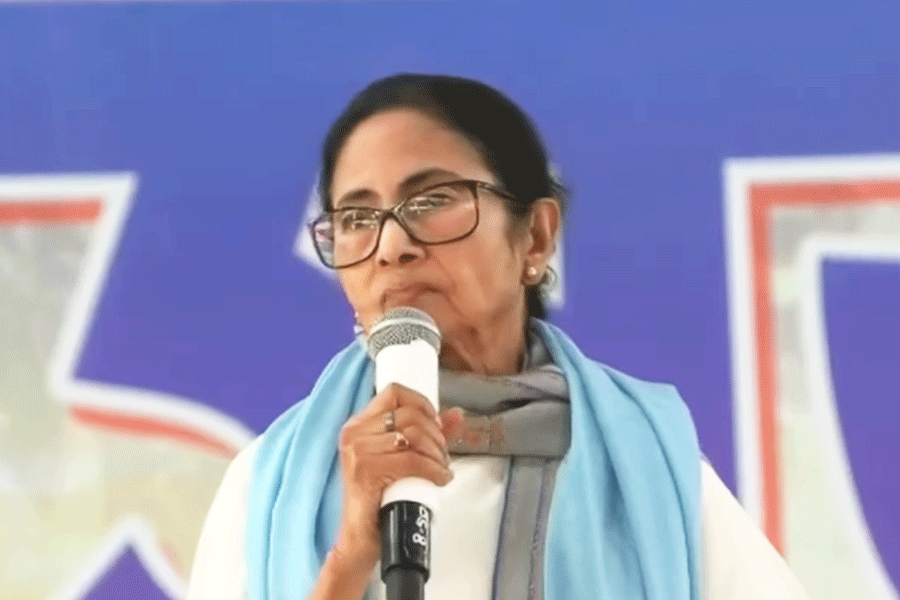|
|
The author is vice-principal, Welham Girls’ School, Dehra Dun
“Oh smiling children, dangerously
gifted ones,
take care that you learn to ask why,
for the room that you are in is also
history.”
— Carol Rumens, “The Hebrew Class”
This is a bad time to be a history teacher. For one thing, few students want to study it seriously, preferring the inducements of science and commerce. What is the relevance of the past when their lives are fixed on the present as the passport to the future? How can one convince them that the past matters more than ever? How can one teach them that their “modernity” co-exists with the most pernicious notions? That their very depoliticization makes them the prey and tool of unscrupulous politicians? That the distance between the upper middle class English-speaking MBA and the young ruffians who attack greeting card shops or tar and feather girls wearing jeans is a very short one?
These and many other questions came to mind while watching Aparna Sen’s Mr and Mrs Iyer. Not least, by her decision to make the film in English. That English is the lingua franca of the literati is now a cliché — what other language could a Tamilian and a Bengali have in common? Certainly not Hindi, to which both have had long traditions of cultural hostility. The knowledge of English subtly confers upon its speakers an aura of progressivism, and modernity.
Yet this is the class whose highly qualified sons and daughters meekly submit to parental authority and social sanctions. One glance at the matrimonial columns of the newspapers is proof of this. Or the colleague, well-travelled and superficially cosmopolitan, who insisted that she wanted only a Brahmin boy for her daughter. (Presumably, the daughter, a US educated banker, had acquiesced.) Nor is it a coincidence that so many fundamentalists, from Muhammad Atta to Praveen Togadia, have a science background. So Sen’s highly qualified (MSc, Physics), sprightly heroine, is upset that she has drunk water from a Muslim, a fellow passenger whom her parents have asked to help her. She confesses later, that her father-in-law, an endocrinologist, is extremely conservative.
On the same bus, another group of passengers articulates the same notions about Muslims, albeit in more profane language, that are current among the so-called literati. And that is another great illusion cherished by the urban upper class: that they are the repository of secularism. Yet how often has one heard a cultivated voice say in exasperation: “I don’t want to say it, but these Muslims go too far … they need to be taught a lesson…” The same remarks were made by “good” Germans about Jews: their fecundity, their clannishness, their plans of dominating the country. It was these notions which the Nazis manipulated, to such murderous effect.
And that brings to mind the notion of stereotypes, which the film seeks to address, (not wholly successfully). For one of the passengers on the bus, which carries a representative microcosm of urban India, is the stereotypical Muslim, an elderly man who insists on saying his namaz in the aisle, regardless of the inconvenience to other passengers. Of course, he’s singled out and suffers the fate hinted at by his false teeth and spectacles discarded by the road. But Raja Choudhury, (played by Rahul Bose) is also a Muslim — to the surprise of Meenakshi Iyer (played by Konkona Sen Sharma). “But you’re a Bengali!” she exclaims. (Implication: “You don’t look like a Muslim.”). Like Anne Frank’s family, he does not make a point about his religious identity, only to find that the rest of the world views him through its prism.
In my senior history class, I have one Muslim girl. Sometimes, to bring home the enormity of stereotyping I actually have to stress that she could just as easily be taken for Sangeeta Kapoor or Neha Gupta.. Many Bosnian or Gujarati Muslims look just like their neighbours. Yet these same people turned on each other after having lived cheek-by-jowl for years. At times like this there is little point of sophisticated exegeses about religious and cultural identity. Mr and Mrs Iyer makes precisely this point.
The film has been attacked for its rather obvious symbolism: the bus, which serves as a microcosm of India. Anyone who has spent a good deal of time travelling on what in north India are known as “Roadways buses”, will find the recognizable types — some may say the film serves up other stereotypes, in place of those it attacks. I found particularly convincing the portrayal of a group of young college students, who are more curious about the unusual couple (Sen Sharma and Bose), asking the usual questions about how they met, and where they had their honeymoon, than they are about the fate of the old man. Yet the goons who board the bus, physically assault one of them, when she agitatedly asks where they are taking the old man. The rest of the passengers remain passive.
One has only to glance at the headlines of major dailies in recent years to record what the Irish poet Seamus Heaney has called “casting the stones of silence” in the face of violence. Train passengers watch helplessly as a girl is raped on a crowded commuter train. A group of friends watches as one of them is battered unconscious by five off-duty policemen. Often an individual response may be inadequate — yet only a hand held out reminds us of our common humanity. Such a response may be an impulse — so Meenakshi Iyer, who has just been shocked at drinking water from a Muslim, dumps her baby on his lap, implying that they are husband and wife. She had not spoken up for the old man — but here was someone whom she had connected with. In the end both young people part with some understanding of each other. The film shows both the inadequacy and humanity of an individual response.
Mr and Mrs Iyer has been criticized for personalizing and romanticizing a very complex problem, and for lumping together different forms of violence. These criticisms have much truth to them. Yet I know, as a teacher, that young people respond better when a problem is given an individual and personal dimension. That is why historical novels, films or autobiographies, teach so much better than the textbook or the teacher. Anne Frank’s diary makes more poignant not only her fate, but also that of her people. The story of Urvashi Butalia’s uncle, left behind in Pakistan, brings immediacy to the fate of so many divided families. Scholars of the social sciences will no doubt have to make profound analyses of the roots of different forms of violence. But at the heart of all violence are individuals destroying other individuals.
Mr and Mrs Iyer does not claim to have all the answers. But by posing the problem at an individual level, and focussing on two young people caught in a situation which forces them to confront their own prejudices and rethink old stereotypes, it echoes the words of the Joni Mitchell song from the tumultuous Sixties:
“I feel to be a cog in something
turning
Well maybe it’s the time of year
Or maybe it’s the time of man
I don’t know who I am
But life is for learning.”
In a recent interview, Aparna Sen has said that the film is her answer to the fundamentalists. Perhaps all those of us who are involved with young people must find our own responses. A friend’s account of a comment she overheard after watching the film is pertinent in this context. The gentleman was incensed that the public was being titillated by a love story between a Hindu girl and a Muslim boy: such films should be burnt, he declared. The comment only validates Aparna Sen’s reasons for making the film, and underlines the importance of its message.











